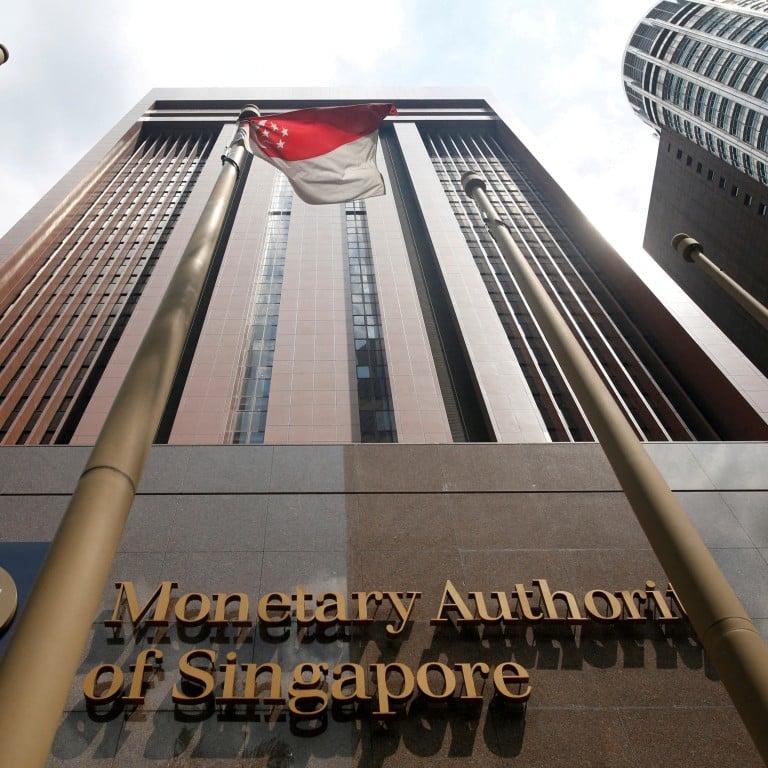
Singapore’s central bank to trial digital currency, mulls use as stepping stone to build tech infrastructure
- Even as it readies to trial digital currency, MAS noted that the case for a retail central bank digital currency (CBDC) is ‘not compelling for now’
- Analysts point out that retail CBDCs may not be of interest to many Singaporean investors, who may prefer to purchase cryptocurrencies
Singapore’s central bank on Monday announced that it was exploring the concept of a purpose-bound digital currency, which can be used to issue government vouchers and payouts among others, though it noted that the case for a retail central bank digital currency (CBDC) is “not compelling for now”.
The purpose-bound digital currency is just the first phase of a larger project in partnership with private firms and a move towards establishing the technical infrastructure and competencies needed for a retail CBDC in the future.
The Monetary Authority of Singapore (MAS) said in a press release that purpose-bound digital currency would allow senders to specify conditions, such as an expiration date of the voucher and types of shops, when making transfers with its digital currency.

In its 55-page report, the MAS defined purpose-bound digital currency as “a protocol that specifies the conditions upon which an underlying digital currency can be used” and that purpose-bound digital currency can be used across different platforms and systems.
This means that use of purpose-bound digital currency could remove the need for voucher users to have a bank account, reduce any misuse of vouchers and speed up payment processes.
Partnering both government and private institutes on trials to test this concept, purpose-based digital currency could be used to digitalise vouchers and support government disbursement programmes, the MAS report stated.
Other organisations that have partnered MAS include DBS, Grab Holdings, Fazz Financial Group and Singapore electronic payments provider Nets.
This comes after MAS chief Ravi Menon’s comments on Singapore’s stance towards cryptocurrency, as Hong Kong moves to legalise retail trading of digital tokens and Singapore eyes plans to impose new restrictions on consumers.
‘No contradiction’ in Singapore’s cryptocurrency rules: central bank chief
He said the city state did not “set ourselves out to compete with other jurisdictions, especially on regulation”, adding that the MAS would work towards containing risks, which primarily harm retail investors.
Sopnendu Mohanty, MAS’ chief fintech officer, said e-money should go beyond just allowing users to store money electronically and carry it along, but should be “programmed and used for specific purposes only”.
Through practical experimentation with the industry, he said the authority had “sharpened our understanding of the potential uses of a digital Singapore dollar and the infrastructure required to support it”.
The press release did not specify when the purpose-bound digital currency will be made available for public use but that selected participants of the Singapore Fintech Festival 2022 will be able to receive vouchers and use the purpose-bound currency as part of the trial.

Woo Jun Jie, senior research fellow at the Institute of Policy Studies at the National University of Singapore, said it was possible the MAS was not scrambling to develop retail CBDCs because the current mechanism for issuing government debt has been able to function sufficiently well.
MAS chief Menon said last year at the launch of the project that while there are benefits of using retail CBDC, such as building an efficient payment ecosystem and mitigating against the encroachment of privately issued stablecoins or foreign CBDCs, the “retail CBDCs can potentially pose significant risks to monetary and financial stability”.
Potential issues such as the disintermediation of the banks during periods of stress and more people holding a significant amount of their deposits in Singapore dollars, which would result in reducing the banks’ capacity to make loans are some examples, he said.
He added that, however, the MAS does recognise the potential benefits of retail CBDC, “should Singapore decide to do so in future”.
In its report on the subject, the MAS wrote that it expected any future retail CBDC would “only form a small part of our money supply, playing a useful but ultimately constrained role in the economy just like physical cash”.
Will ‘crypto winter’ leave Asia’s DeFi, NFT adopters out in the cold?
The MAS remained “mindful that the case for a retail CBDC in Singapore remains open at this point” given the rapid pace of development in the sector.
But retail CBDCs may not even be something that many Singaporean investors are interested in, experts said.
Woo, who also conducts research on cryptocurrency regulation, said there was likely to be “limited interest or demand for retail CBDCs” and that the public would be more inclined to purchase cryptocurrencies.
“For investors, cryptocurrencies are attractive because of their volatility and hence, arbitrage opportunities. CBDCs, on the other hand, are more stable and therefore function only as a store of value, a function which is already played by government bonds,” he said.
With about 90 per cent of the world’s central banks using, trialling or exploring CBDCs, most are hopping on board to prevent being left behind even as they continue to navigate the technological complexities.
Financial messaging system Swift unveiled its blueprint for a global CBDC network earlier this month, after an eight-month experiment on different technologies and currency.

